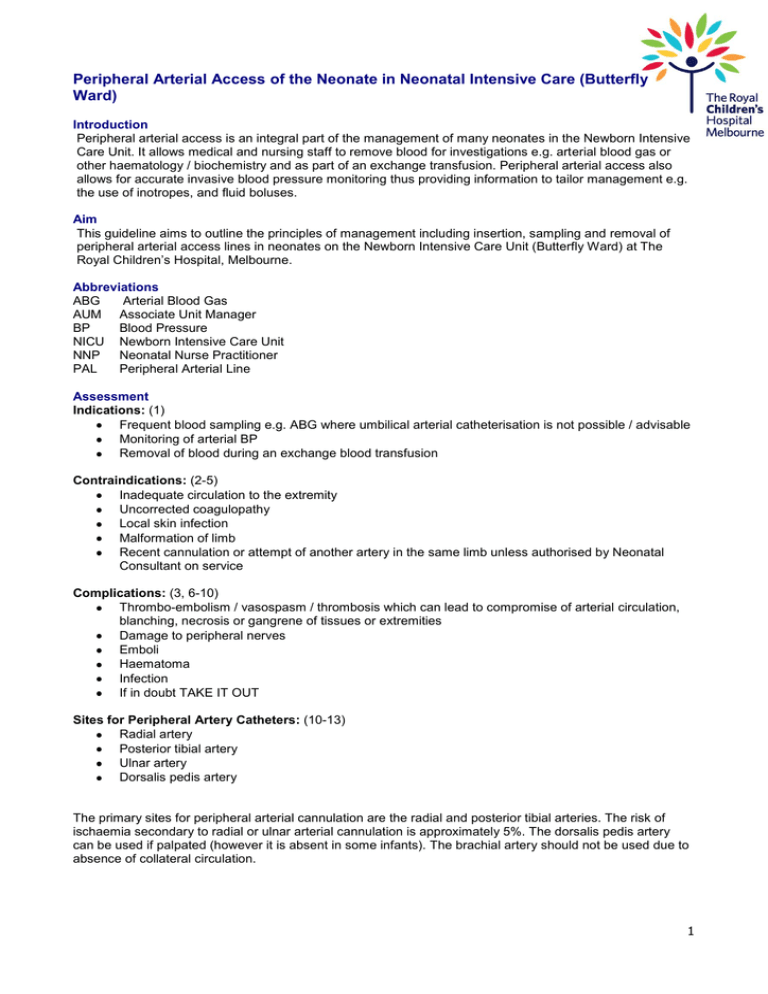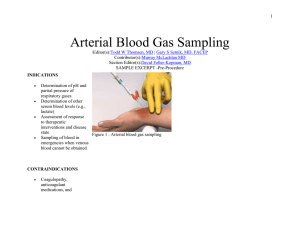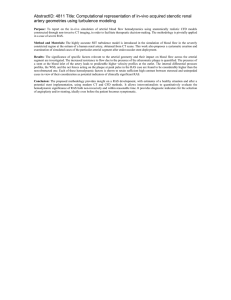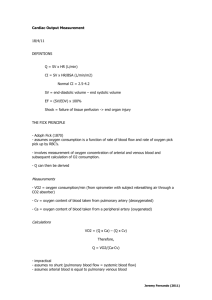Peripheral arterial access of the neonate
advertisement

Peripheral Arterial Access of the Neonate in Neonatal Intensive Care (Butterfly Ward) Introduction Peripheral arterial access is an integral part of the management of many neonates in the Newborn Intensive Care Unit. It allows medical and nursing staff to remove blood for investigations e.g. arterial blood gas or other haematology / biochemistry and as part of an exchange transfusion. Peripheral arterial access also allows for accurate invasive blood pressure monitoring thus providing information to tailor management e.g. the use of inotropes, and fluid boluses. Aim This guideline aims to outline the principles of management including insertion, sampling and removal of peripheral arterial access lines in neonates on the Newborn Intensive Care Unit (Butterfly Ward) at The Royal Children’s Hospital, Melbourne. Abbreviations ABG Arterial Blood Gas AUM Associate Unit Manager BP Blood Pressure NICU Newborn Intensive Care Unit NNP Neonatal Nurse Practitioner PAL Peripheral Arterial Line Assessment Indications: (1) Frequent blood sampling e.g. ABG where umbilical arterial catheterisation is not possible / advisable Monitoring of arterial BP Removal of blood during an exchange blood transfusion Contraindications: (2-5) Inadequate circulation to the extremity Uncorrected coagulopathy Local skin infection Malformation of limb Recent cannulation or attempt of another artery in the same limb unless authorised by Neonatal Consultant on service Complications: (3, 6-10) Thrombo-embolism / vasospasm / thrombosis which can lead to compromise of arterial circulation, blanching, necrosis or gangrene of tissues or extremities Damage to peripheral nerves Emboli Haematoma Infection If in doubt TAKE IT OUT Sites for Peripheral Artery Catheters: (10-13) Radial artery Posterior tibial artery Ulnar artery Dorsalis pedis artery The primary sites for peripheral arterial cannulation are the radial and posterior tibial arteries. The risk of ischaemia secondary to radial or ulnar arterial cannulation is approximately 5%. The dorsalis pedis artery can be used if palpated (however it is absent in some infants). The brachial artery should not be used due to absence of collateral circulation. 1 Allen’s Test: (14) Only an artery with collateral circulation should be cannulated. Accessing collateral circulation can be achieved by performing the Allen’s test if using an upper limb. The Allen’s Test is a measurement of radial or ulnar patency. Performing the Allen’s test in a neonate involves elevating the arm and simultaneously occluding the radial and ulnar arteries at the wrist, then rubbing the palm to cause blanching. Release the pressure on the ulnar artery (see diagram below). If normal colour returns to the palm in <10 seconds adequate ulnar circulation is present. Performing and reporting the results of the Allen’s Test must be documented in the medical record. Equipment: Cleaned procedure trolley Trans-illuminator Sterile dressing pack Sterile gloves Chlorhexidine 1% cleaning solution 24G intravenous cannula 5ml syringe flushed with heparinised saline 50units in 5mls Luer-lock 10cm BD Connecta flushed with heparinised saline 50units in 5mls Tapes & Tegaderm for securing the line Splint / arm-board Long extension line – minimum volume extension tubing 50mls saline with: o 50 units heparin in 50mls 0.9%saline if neonate <2500g o 250 units heparin in 50mls 0.9%saline if neonate >2500g Transducer set and cable Syringe pump Analgesia / Sedation: This is a painful procedure. In most instances a neonate requiring an arterial line is unwell and will usually have morphine and/or midazolam infusions prescribed. A bolus may be required prior to commencement of the procedure. Oral sucrose can be given if no contraindications apply. Management Precautions: (2, 15) Avoid hyperextension of the joint as this may lead to occlusion of the artery Attempt insertion of no more than one artery. Seek senior help before further attempts Always ensure that the tips of the fingers / toes are exposed so that perfusion can be checked regularly 2 Preparation and Procedure: Wash hands and prepare work surface and equipment Perform Allen test to check for adequacy of collateral circulation Slightly extend the wrist / ankle to bring the artery closer to the surface Identify the artery by palpation +/- trans-illumination Rewash hands and don gloves Clean the skin with chlorhexidine 1% cleaning solution Insert the 24G cannula over the artery at an angle of 30 - 45 degrees Puncture the artery and watch for blood in the hub of the cannula Withdraw the stylet whilst advancing the cannula slowly. There may be spasm from the artery having been touched hence blood return may be delayed Observe the cannula hub for pulsative blood flow Attach the cannula to the arterial connector and three-way tap and slowly flush with heparinised saline 50units in 5mls Turn off the three-way tap and secure the cannula with tape, and a splint Connect the10cm luer-lock, transducer set up and heparinised saline 50ml syringe Identify the line as an arterial line by placing a red arterial line sticker on the infusion line Observe the fingers / toes for circulation and warmth post procedure Level and zero the pressure transducer and set MEAN alarm limits as per medical preference Document blood pressure limits on neonatal fluid balance and treatment orders chart Document procedure in the medical record Secure with splint and strapping as per Butterfly Ward peripheral arterial line strapping reference guide (Neonatal Medicine Intranet Resources) Sampling from Peripheral Arterial Line: Equipment needed: o 2ml syringe o Blood gas syringe +/- syringe for blood collection o 2ml syringe with saline o Small Q tip / cotton bud o Alcohol prep swab o Red IV cap Wash hands and prepare work surface Turn three-way tap 45 degrees ensuring no port will be open to air Attach 2ml syringe to exit port of three-way tap Turn three-way tap off to infusion line and open to neonate and exit port then aspirate blood slowly from the neonate into the syringe Withdraw into the syringe enough blood to clear the arterial connector line of heparinised saline (2.0mls is usually sufficient) Turn three way tap to 45 degrees ensuring no port will be open to air Remove syringe from three-way tap and connect blood gas syringe / or syringe for blood sample collection Turn three-way tap so that blood can be aspirated from neonate into the syringe Once sufficient blood collection has occurred turn three-way tap 45 degrees ensuring no port will be open to air Remove this syringe and replace with original syringe of aspirated blood and heparinised saline ensuring no air is present in the syringe Slowly return the contents of this syringe back to the neonate observing for signs of arterial spasm such as blanching Turn three way tap to 45 degrees ensuring no port will be open to air Replace this syringe with 2ml syringe containing normal saline Slowly flush the arterial connector and line with normal saline until the line is cleared of blood (1 1.5mls is usually sufficient) Turn three way tap to 45 degrees ensuring no port will be open to air Cover the Q tip / cotton bud with alcohol prep and insert into exit port after removing the syringe and clean the port opening Once cleaned close the port opening with the new red IV cap Turn three-way tap open to infusion of heparinised saline and neonate and closed to the exit port and commence infusion 3 Observe digits and limb for colour, warmth and circulation and record on observation chart Send blood samples as requested Document procedure and investigations on observation chart Nursing Management: (2, 10) Careful positioning of the limb with the PAL in-situ Ensure the tips of the fingers / toes are exposed at all times Observe for adequate patency of artery by ensuring digits and limb are pink, warm and well perfused Inspect and document hourly the area distal and proximal to the insertion site for blanching, redness, cyanosis and changes in temperature and perfusion Report to AUM / NNP / medical team if there are changes to circulation of the limb or digits Level and zero arterial line at commencement of every shift and if patient is turned / moved Heparinised saline only to be administered as a continual infusion at between 0.5 – 1.0ml/hour Change heparinised saline infusion syringe every 24 hours and infusion line every third day Arterial line is only to be used for blood sampling and blood pressure monitoring Removal of Peripheral Arterial Line (2, 10, 11) Wash hands and prepare work surface Switch off heparinised saline infusion Remove tapes carefully to ensure skin integrity Withdraw the cannula and apply pressure to the site for 5 minutes with a piece of sterile gauze / cotton ball ensuring circulation to the hand / foot is maintained Check to see if the bleeding has stopped. If it has not apply pressure for a further 2 – 3 minutes before checking again – repeat this step as needed Once bleeding has stopped cover the site with a small piece of gauze and tape / film dressing Observe the digits and limb for adequate circulation and continue to monitor for the next four hours Document procedure in the medical record Companion Documents Sucrose (oral) for procedural pain management in infants (Hospital Clinical Guideline) Umbilical arterial catheterisation of the newborn guideline (Neonatal Intensive Care) CVAD management Procedure (Hospital Procedure) Butterfly Ward peripheral arterial line strapping reference guide (Neonatal Medicine Intranet Resources) References 1. Abubakar, M. (2007) Atlas of Procedures in Noenatology, MacDonald, M. & Ramasthu, J. (Eds) Pub: Wotters Kluwer / Lippincott Williams & Wilkins 2. Norforlk, Suffolk & Cambridgeshire Neonatal Netwrok. Clinical Guideline: Peripheral Arterial Cannulation 2007 Downloaded 22/03/2013 http://www.neonatal.org.uk/documents/3270.pdf 3. Sawyer, T.L. (2013) “Radial Arterial Cannulation” Medscape Reference Drugs, Diseases & Procedures, Accessed 22/03/2013 http://emedicine.medscape.com/article/80450-overview 4. Mitchell, J.D. & Welsby, I.J. (2004) “Techniques of Arterial Access” Surgery, 3-4,22(1) 5. Roberts, J. & Hrdges, J. (2004) “Arterial Puncture and Cannulation” In Clinical Procedures in Emergency medicine. 4. WB Saunders: Philadelphia pp. 384-399. 6. Hack, W.W. Vos, A. & Okkena, A. (1990) “Incidence of forearm and hand ischaemia related to radial artery cannulation in newborn infants”, Intensive care Medicine Vol 16(1), pp. 50-53 7. Schnidler, E. Kowald, B. et al (2005) “Catheterisation of the radial or brachial artery in neaonates and infants”, Paediatric Anaesthesiology, Vol 15(8), pp. 677-682. 8. Furfaro, S. Gauthier, M. Et al (1991) “Arterial catheter-related infections in children. A 1 year cohort analysis”, American Journal of Disease in Childhood, Vol 145(9), pp. 1037-43. 9. MacDonald, M.G. (2002) “Peripheral Artery Cannulation Chb29, In: MacDonald, M.G. & Ramasethu, J. Atlas of Procedures in Neonatology, 3rd Ed. Lippincott Williams & Wilkins, Philadelphia 10. Kaleidoscope The Children’s Health Network (2011) “Peripheral Arterial Line in NICU – Insertion, Care and Removal of”, Guideline / Procedure Accessed 26/03/2013 http://www.kaleidoscope.org.au/docs/gl/pal_nicu.pdf 11. Newborn Services Clinical Guide (2006) ‘Intravascular Catheters peripheral Arterial Lines”, Accessed on 22/03/2013 http://www.adhb.govt.nz/newborn/guidelines/vascularcatheters/ivc_peripharteriallines. 4 12. Ramasethu. J. (2008) “Complications of vascular catheters in the NICU” Clinical Perinatology pp. 199-222 13. Massaro, A.N. Rais-Bahrami, K. & Eichelberger, M.R. (2007) Atlas of Procedures in Neonatology, MacDonald, M. & Ramasthu, J. Eds, Pub Wotters Kluwer/Lippincott Williams & Wilkins 14. Medical Dictionary for the Health professions and Nursing (2012) Accessed 26/03/2013 www.medical-dictionary.thefreedictionary.com/Allen’s +test. 5





